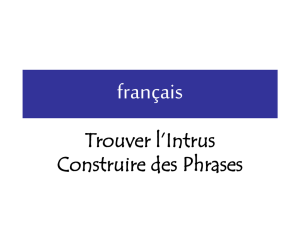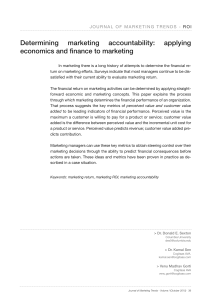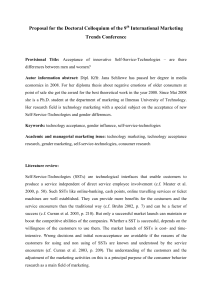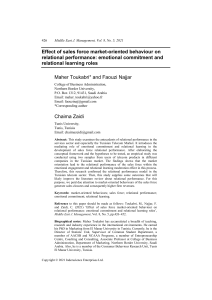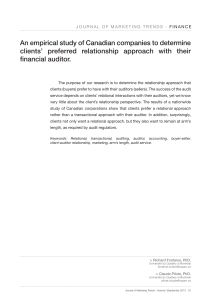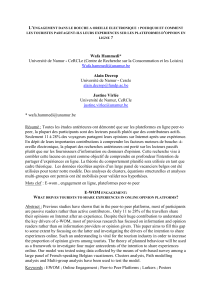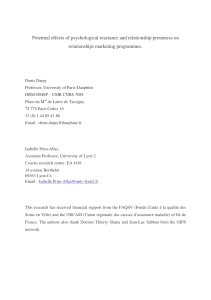- International Marketing Trends Conference
publicité
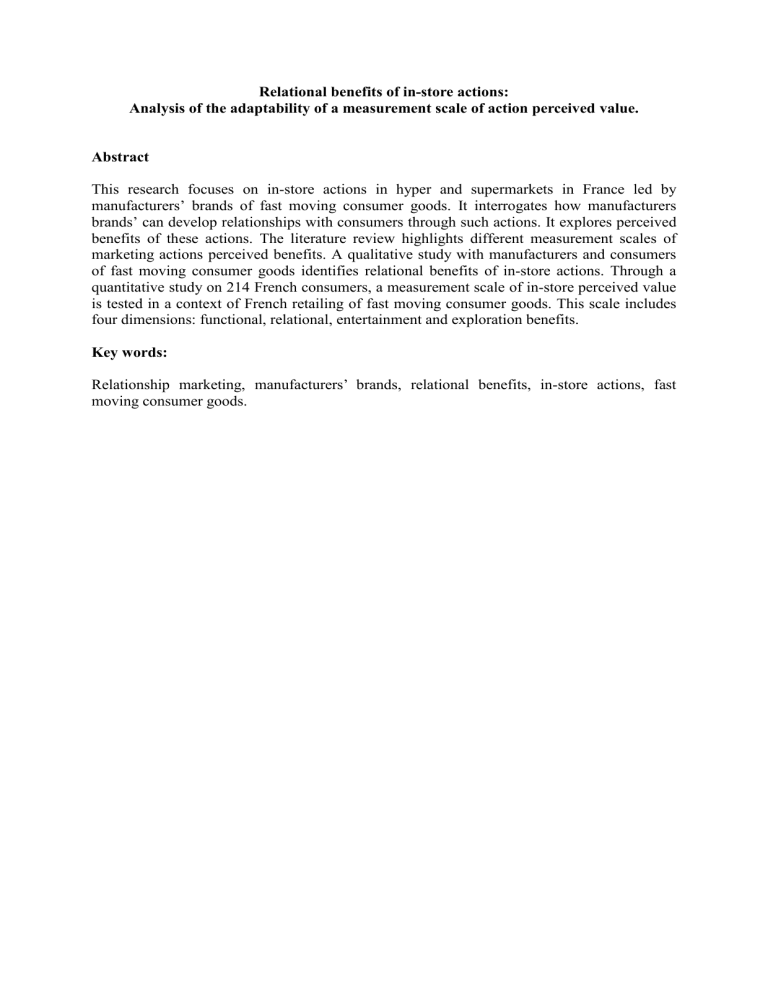
Relational benefits of in-store actions: Analysis of the adaptability of a measurement scale of action perceived value. Abstract This research focuses on in-store actions in hyper and supermarkets in France led by manufacturers’ brands of fast moving consumer goods. It interrogates how manufacturers brands’ can develop relationships with consumers through such actions. It explores perceived benefits of these actions. The literature review highlights different measurement scales of marketing actions perceived benefits. A qualitative study with manufacturers and consumers of fast moving consumer goods identifies relational benefits of in-store actions. Through a quantitative study on 214 French consumers, a measurement scale of in-store perceived value is tested in a context of French retailing of fast moving consumer goods. This scale includes four dimensions: functional, relational, entertainment and exploration benefits. Key words: Relationship marketing, manufacturers’ brands, relational benefits, in-store actions, fast moving consumer goods. Introduction In September 2013, in French hyper and supermarkets all Milka chocolate bars will have one square of chocolate missing. This in-store action is part of a campaign also present on the Internet and called “Où est passé le dernier carré”. Consumers can choose to send the missing square of chocolate to friends or to themselves. It clearly appears that benefits from such an action are of a relational order. It intends to diffuse the value of Milka: tenderness and to share it with consumers. It also fosters the link between the consumer, his or her friends and the brand. For most frequently purchased packaged goods distributed in the super-hypermarket channel, the store is where a manufacturer’s brand can meet with the consumer and interact with him. Indeed, in a context of self-service the shelf is the place where the consumer can see and interact with the brand. It is the place where the efforts made by the latter can be highlighted. This research interrogates how fast moving consumer goods manufacturers brands can develop relationships with consumers through in-store actions. For that, we explore perceived value of these actions. We first present a literature review highlighting different measurement scales of perceived benefits. Afterwards, we develop the results of a qualitative study with manufacturers and consumers of fast moving consumer goods that identifies relational benefits of such in-store actions. Actions implemented by manufacturers’ brands are the reflection of evidence of the willingness of the latter to retain consumers. On one hand, actions present functional benefits such as monetary or time savings. On the other hand, these same actions can develop relational value, entertainment and exploration benefits for the consumer. We characterize these impacts in an empirical application involving ice cream major brands pertaining to the frequently purchased packaged goods sector and distributed in supermarkets and hypermarkets. We test our scale through a quantitative study. Finally we offer the conclusion of our research, its implications and limitations. 1. Literature review 1.1. Relationship marketing and attribution theory Relationship marketing brings together "all activities to establish, develop and maintain successful relationship exchanges" (Morgan and Hunt 1994). It offers more interactive exchanges between consumers and brands, and it is thus opposed to a more traditional vision of marketing where the company acts and the consumer responds (Möller and Halinen 2000). In its full development, the relationship is mutually beneficial to the parties involved (Barnes 1994; Berry 1995). A link is developed between the two parties. The literature has studied these links between consumers and brands (Fournier 1998; O'Malley and Tynan 1999; Heilbrunn 2003) and proposed concepts for measuring the strength of the various components of relationship (Breivik 2008 and Thorbjørnsen; Vesel and Zabkar 2010). Attribution theory states that the benefits of relationship marketing are attributed to the entity perceived as having control on their production (Palmatier et al. 2007). Ensuring that consumers perceive its efforts, the brand reinforces their gratitude (Palmatier et al. 2009). It is relevant for manufacturers’ brands to put in place actions and marketing strategies that deliver relational benefits to the consumer. Relationships between consumers and brands can be developed and maintained through the interactions that actors maintain day to day (De Wulf Odekerken-Schröder and Van Kenhove 2003). Each contact between the actors involved in the relationship contributes to its development thanks to promises (Bitner 1995) and perceived relationship investment (De Wulf Odekerken-Schröder and Iacobucci 2001). Companies put 2 in place relational programs to develop customer loyalty (Meyer-waarden 2005) that provide three different categories of benefits for the consumer (Mimouni 2005). 1.2. Perceived relational value In relationship marketing, some works offer a definition of marketing in terms of benefits. Gwinner (1998) states that there has to be benefits for the different parts of a relationship for it to work. These relational benefits are psychological: confort, security, trust as well as economic and social with the expression of preferential treatment or personal acknowledgement. On top of that, marketing relationship theory presents benefit exchanges that arise from relationships per se (Vesel and Zabkar 2010). During the exchange process, value is given and received (Day 2000). This value has six components: functional knowledge, experiential simulation, social link, self-expression and spiritual value (Aurier et al. 2004). Different elements of relationship marketing strategies present relational value. In the banking sector, relational orientation vehicles economic and emotional benefits in the short and long term (Benamour and Prim 2000). Loyalty programs that are an important part of relationship marketing are for instance providing utilitarian, hedonic and recognition benefits (Mimouni 2005) to consumers. The consumers maximize utilitarian benefits through monetary savings and simplification of access to products. Hedonic benefits are of two forms: pleasure of reward and participation in the process. Finally the benefit of recognition reinforces the feeling of being treated with consideration. In-store actions are however a way for the brand to express relational orientation towards consumers, and create a relationship with them. 1.3 In-store actions perceived benefits measurement scales In-store actions are mainly discussed in the literature in their promotional angle (Chandon 1995; Desmet 2007) and are widely used because of their effect on the acceleration of purchases (Neslin Henderson and Quelch 1987) in a transactional perspective. We explore the different benefits of these actions. In fact, store is a place where a manufacturer’s brand can develop its image and its evaluation through an informal control over the purchase experience. In-store brand expression (Aurier and Lanauze 2011) covers the different non-product elements of the brand marketing expression addressed to the consumer during the in-store encounter. Habib (2011) underlines value that can be drawn from the shopping experience: aesthetic, playful value, price efficiency, interactions with staff, social environment, environmental and social commitment. Finally, a scale is presented to measure the benefits drawn specifically from the encounter with an action in store (Chandon Wansink and Laurent 2000). They are of two kinds: utilitarian and hedonic benefits. The consumer perceives benefits through monetary savings, quality, convenience, value expression, exploration and entertainment. De Peichpeyrou (2006) develops the perceived sincerity of promotional offer. It implies that relational benefits can be drawn from in-store actions. 2. Method The literature review allowed us to compile different measurement scales of perceived benefits of in-store actions and of relational benefits of marketing programs. To complete this literature review, we conducted a qualitative study to better define the concept of consumer brand relationship and identify perceived benefits of action for both brand manufacturers and 3 consumers. We conducted 18 semi-structured interviews with marketing professionals. The interviews, lasting an average of 30 minutes, were made individually, by telephone or face to face. These interviews were supplemented by 10 interviews with consumers, of an average length of 45 minutes. The use of Kelly triads during interviews with consumers helped examining how they perceive their interactions with manufacturers’ brands and how they understand their classifications of in-store actions. We did a content analysis in three steps: cutting text into themes, categorizing and analyzing them using N'Vivo software. A quantitative study followed this exploratory study to test the adapted scale. The online questionnaire was about in-store actions led by major brands positioned in frequently purchased packaged goods categories (ice cream). With the 214 responses, we used SPSS statistics 20 and we did a Principal Components Analysis to eliminate items that were not affected to any dimensions (Evrard Pras and Roux 2009). We then tested reliability of the scale. 3. Results: Development of a measurement scale of perceived value of in-store actions 3.1. Results of qualitative study: perceived benefits of in-store actions In-store actions implemented by manufacturers’ brands have been little studied, to our knowledge, in a relational perspective. The different studies (Chandon Wansink and Laurent 2000; de Pechpeyrou et. al 2006) have underlined functional and hedonic benefits of in-store actions in the context of French retailing. We found these elements in the discourses of consumers. In the discourses of manufacturers and consumers, elements bound to relational benefits tend to appear. For manufacturers, in-store actions are a way to strengthen contacts with consumers. They are sources of experience in link with the brand. For consumers, these actions provide relational benefits, consistent with the pleasure of being given something or participating in a dialogue with the brand. Actions perceived benefits Monetary savings Functional Time savings Functional Convenience Functional Exploration Functional Verbatims « Les réductions tu te dis que c’est un peu bête de pas profiter des réductions parce que si t’achètes après au tarif normal tu te fais avoir. » (M.) « Ce qui attire mon attention c’est les actions promotionnelles liées au prix. Plus précisément, quand t’achètes une pièce t’as la deuxième soit à 50% soit gratuit. » (A.) « La promotion ça attire mon attention et je trouve tout de suite ce que je cherchais. » (S.) « Il faut juste rappeler les gens que ça existe » (A.) « Si le prix est correct, ça attire mon attention, je vais acheter plutôt ça, parce que les pâtes ça se conserve. » (M.) « La dégustation produits je goûte pas trop, très peu en fait. Ca arrive pour le fromage, pour le saucisson… Ca permet de voir si le produit est bon pour savoir si on va l’acheter après» (M.) « La dernière fois j’avais acheté un truc intéressant : confit de canard, c’était Delpeyrat je crois, y’avait 50%. 4 C’était Delpeyrat ? Je sais plus la marque… Je l’ai vu dans le rayon, j’ai vu 50%, c’était une boite donc ca se conserve bien je me suis dit pour une occasion, pour plus tard. » (C.) Discovery of new Functional « Y’a des choses tu te dis c’est malin, j’y aurais pas products pensé. » (J.) « Si t’as pas vu quelque chose il va attirer ton attention qu’il existe quelque chose sur le marché et c’est possible que t’auras besoin de ce type de produits mais tu l’as pas vu. » (A.) Feeling of pride Hedonic « Tu vois je fais le ratio pour savoir si en qualité/prix ca vaut le coup, si j’ai déniché quelque chose d’intéressant » (B.) Interest Hedonic « La plupart du temps t’achètes un fromage il te donne un plat pour faire de la fondue de fromage. C’est intéressant car ils complètent les produits d’une manière sympa et intelligente. » (A.) Entertainment Hedonic « Des fois dans le rayon fruits et légumes, y’a des dégustations. C’est marrant, ça fait rigoler. » (C.) Pleasure / Hedonic « Les marques qui font des promotions en magasin c’est Agreeability plutôt agréable » (M.) Proximity Relational «Je vais à Carrefour et avec Nutella je vois qu’on peut gagner une Mini. Y’en avait même une en plein milieu du magasin… C’est ma voiture préférée… » (S.) « Quand j’achète en promo c’est qu’ils ont un coté novateur. Ils font quelque chose de différent dans le rayon» (J.) Dialogue Relational « Le cadeau dans les céréales c’est mignon» (C.) « C’est intéressant quand même ça crée quelque chose d’affectif car on m’a donné quelque chose. » (A.) « La fille dans le rayon si elle est pas sympa ben j’aurai une mauvaise image de Pepsi » (B.) Trust Relational « Généralement, la marque c’est associé à la qualité. Les promos ça va conforter l’image que j’ai de la marque. » (J.) « Je me dis là c’est vraiment intéressant, le prix au kilo est bien plus bas mais j’ai la qualité de la marque, c’est comme s’ils avaient fait un effort pour une fois » (S.) Table 1: Perceived benefits of in-store actions: verbatims Consumers and manufacturers tend to associate some types of in-store actions to different benefits. For instance, functional value is strongly felt in the immediate reduction vouchers and virtual prizes that have similar mechanics. The animations tend to have high hedonic value while the distribution of gifts and samples tend to trigger relational benefits. 3.2. Generation of items and scale development Our research objective is to develop a measurement scale of perceived value of in-store actions, including relational benefits. It also includes hedonic and functional benefits. A measurement scale of in-store actions benefits has been developed by Chandon, Wansink and 5 Laurent (2000) but it mainly includes benefits of promotion. Our intent is to complete it with the incorporation of a third dimension of benefits: relational benefits. The exploratory study highlights these 3 dimensions and 10 sub dimensions of perceived benefits and leads us to retain 21 items. The items are formulated in French for the specificities of the French retailing sector. Dimension Sub-dimensions Item formulation Functional Convenience / Cette action me facilite la vie benefits Time savings Cela me fait gagner du temps Cela me permet de me rappeler que j’ai besoin du produit Discovery Exploration Monetary savings / Avec cette action je découvre des produits que je n’aurais pas pu découvrir autrement Cela me fait essayer de nouveaux produits Je fais des économies Je sens que je fais une bonne affaire Je dépense moins Hedonic benefits Feeling of pride / Je me dis que je suis un(e) acheteur(se) efficace Value expression Je suis fier(e) de mon achat Interest Cette action rend le produit attrayant Entertainment Cette action est amusante Cette action est divertissante Pleasure Agreeability Relational benefits Proximity Shared values Dialogue / Je trouve que c’est agréable de participer à une telle action Je me fais plaisir quand je bénéficie d’une action comme celle là / Grâce à une action de ce type, je me sens proche de la marque Cette action me donne le sentiment que j’ai les mêmes valeurs que la marque Avec cette action, la marque s’occupe de moi Avec cette action, la marque s’adresse directement à moi Sincerity / trust C’est une action sincère Avec cette action la marque ne cherche pas à me tromper Table 2: List of items of the measurement scale of in-store actions perceived value This adapted scale has been administered through an online questionnaire. Respondents were invited to evaluate four different in-store actions among four brands of ice cream distributed in hyper and supermarkets. After having indicated a choice of brand and having been exposed to one action, respondents had to fill out a scale of perceived benefits. We intent to compare and analyze variations between in-store actions to see if this scale can be used for every type of action. 6 214 questionnaires have been analyzed. The sample is made of 69.5% of women and 30.5% of men from 20 to 81 years old. 3.3. Evaluation of scale properties The analysis of the scale is made to have the factorial structure of the scale emerge spontaneously while reducing the number of items. In a first time, we did Principal Components Analysis with Varimax rotation. KMO test (0.895) is meritorious and it indicates that the correlation between items is of good quality. Bartlett sphericity (Chi – 2 = 4193.99; p < 0.000) indicates a suitability of data for factorization. Kaiser criterion suggests the existence of four factors reporting more than 70% of variance (75.43%). After Varimax rotation, the Principal Components Analysis lets appear a very clear structure with the four following factors: functional benefits, relational benefits, entertainment benefits and exploration benefits. We choose to eliminate the following item: “Cela me permet de me rappeler que j’ai besoin du produit” while items “Avec cette action je découvre des produits que je n’aurais pas pu découvrir autrement” and “Cela me fait essayer de nouveaux produits” constitute a single factor: exploration benefits, distinct from functional benefits. We code them EXPL3 and EXPL2. Items “Je me dis que je suis un(e) acheteur(se) efficace” et “Je suis fier(e) de mon achat” that reflect the feeling of pride seem to be part of factor 1: functional benefits and distinct from hedonic benefits. We code them FCT6 and FCT7. % of explained variance Factor 1: Functional benefits 23,497 2: Relational benefits 21,672 3: Entertainment benefits 19,148 4: 11,113 Exploration Code Item FCT3 FCT5 FCT4 FCT6 FCT1 FCT7 FCT2 RLT 3 RLT 5 RLT 2 RLT1 RLT 4 RLT 6 HED2 HED3 HED4 HED1 HED5 EXPL3 Loadings Communality 0.890 0.883 0.879 0.799 0.718 0.688 0.659 0.816 0.800 0.780 0.764 0.757 0.717 0.888 0.866 0.807 0.735 0.707 0.867 0.797 0.787 0.807 0.711 0.618 0.650 0.574 0.823 0.730 0.781 0.797 0.755 0.639 0.859 0.871 0.855 0.741 0.746 0.882 7 benefits EXPL2 0.858 0.881 Total explained variance: Scale: 4 factors 75,429% Sample n = 214 Table 3: Factorial structure from PCA of in-store actions benefits measurement scale after Varimax rotation and purification Reliability of the measuring scale is assessed by means of Cronbach's alpha (internal consistency test.) This indicator lies between 0 and 1. If the items are correlated with each other Cronbach's alpha tends towards 1, otherwise it tends towards 0. Regarding our scale each dimension has a good degree of consistency as well as the full scale that also has a good alpha (superior to 0.90). Dimension Item formulation Functional benefits FCT3. Je fais des économies 0.92 FCT5. Je dépense moins FCT4. Je sens que je fais une bonne affaire FCT6. Je me dis que je suis un(e) acheteur(se) efficace FCT1. Cette action me facilite la vie FCT7. Je suis fier(e) de mon achat FCT2. Cela me fait gagner du temps RLT3. Avec cette action, la marque s’occupe de moi 0.93 RLT5. C’est une action sincère RLT2. Cette action me donne le sentiment que j’ai les mêmes valeurs que la marque RLT1. Grâce à une action de ce type, je me sens proche de la marque RLT4. Avec cette action, la marque s’adresse directement à moi RLT6. Avec cette action la marque ne cherche pas à me tromper HED2. Cette action est amusante 0.93 HED3. Cette action est divertissante HED4. Je trouve que c’est agréable de participer à une telle action HED1. Cette action rend le produit attrayant HED5 Je me fais plaisir quand je bénéficie d’une action comme celle là Relational benefits Entertainment benefits Alpha Exploration benefits EXPL3. Cela me fait essayer de nouveaux produits 0.92 EXPL2. Avec cette action je découvre des produits que je n’aurais pas pu découvrir autrement Total scale 0.94 Table 4: Reliability of the measurement scale 8 Conclusion, limitations and future research Through this research we developed a scale to measure in-store actions perceived benefits in 20 items and 4 dimensions. This research contributes to the field of research on value and on in-store actions. We present modifications and adaptation of previous measurement scales. The main interest of this research constitutes the addition of relational benefits in the measurement of in-store actions perceived value. On top of that, the feeling of pride seems to be closer to functional benefits than to entertainment ones. Operationally, the results of this research provide a useful reflection for manufacturers’ brands. In-store actions that provide relational benefits can counter the lack of differentiation from the competition. It is critical for brand managers to take into account the types of consumer benefits provided by in-store actions to increase their effectiveness. The application of this measurement scale will determine the dimensions of in-store actions perceived value that are predominant for each type of action. It will help identifying the elements that create relational benefits for consumers. From there the manufacturers’ brand can identify valuecreating strategies for clients and thus provide ways to create and develop relationships with consumers. The limitations of our study are also future lines of research. Mainly we intend to do further testing, in other categories of products. The first research perspective that we propose is to study categories of product with a cognitive treatment for the consumer to see if the relational benefits have the same importance. Afterwards, we could test the scale on non-alimentary products to better understand the impact of other variables on the perceived value on one hand and develop the external validity of our results on the other hand. References Aurier, Philipe, Yves Evrard, and Gilles N’Goala (2004), “Comprendre et mesurer la valeur du point de vue du consommateur,” Recherche et applications en marketing, 19, 1–20. Aurier, Philippe, and Gilles Séré De Lanauze (2011), “Impacts of in-store manufacturer brand expression on perceived value, relationship quality and attitudinal loyalty,” International Journal of Retail & Distribution Management, 39(11), 810–35. Barnes, James G (1994), “Close to the customer: But is it really a relationship?,” Journal of Marketing Management, 10(7), 561–70. Benamour, Yasmine, and Isabelle Prim (2000), “Orientation relationnelle versus transactionnelle du client : developpement d’une echelle dans le secteur bancaire français.,” in Actes du 16ème congrès de l’association française du marketing, 1–18. Berry, Leonard L (1995), “Relationship marketing of services - Growing interest, emerging perspectives,” Journal of the Academy of Marketing Science, 23(4), 236–45. Bitner, Mary Jo (1995), “Building service relationships: it’s all about promises,” Journal of the Academy of Marketing Science, 23(4), 246–51. Breivik, Einar, and Helge Thorbjørnsen (2008), “Consumer brand relationships: an investigation of two alternative models,” Journal of the Academy of Marketing Science, 36(4), 443–72. Chandon, Pierre (1995), “Consumer Research on Sales Promotions : A State-of-the-Art Literature Review,” Journal of Marketing Management, 11, 419–41. Chandon, Pierre, Brian Wansink, and Gilles Laurent (2000), “A benefit congruency framework of sales promotion effectiveness,” Journal of Marketing, 64, 65–81. Day, George S (2000), “Managing market relationships,” Journal of the Academy of Marketing Science, 28(1), 24–30. 9 De Pechpeyrou Pauline, Béatrice Parguel, Mimouni Aïda and Desmet Pierre (2006), « Valeur et sincérité perçues d’une promotion multi-mécanismes », Recherche et Applications en Marketing, 21(4), 25-39. De Wulf, Kristof, Gaby Odekerken-Schröder, and Dawn Iacobucci (2001), “Investments in Consumer Relationships: A Cross-Country and Cross-Industry Exploration,” Journal of Marketing, 65(4), 33–50. De Wulf, Kristof, Gaby Odekerken-Schröder, and Patrick Van Kenhove (2003), “Investments in consumer relationships: a critical reassessment and model extension,” International Review of Retail, Distribution & Consumer Research, 13(3), 245–61. Desmet, Pierre (2007), La promotion des ventes: du 13 à la douzaine à la fidélisation, (Dunod, ed.), 381. Evrard, Y, B Pras, and E Roux (2009), Market: Fondements et méthodes des recherches en marketing, Dunod. Fournier, Susan (1998), “Consumers and their brands: Developing relationship theory in consumer research,” Journal of Consumer Research, 24(4), 343–73. Gwinner, Kevin P, Dwayne D Gremler, and Mary Jo Bitner (1998), “Relational Benefits in Services Industries : The Customer’ s Perspective,” Journal of the Academy of marketing, 26(2), 101-114. Heilbrunn, Benoît (2003), “Modalités et enjeux de la relation consommateur-marque.,” Revue française de gestion, 29(145), 131–44. Habib, Nawel, and Yves Negro (2011), “Les antécédents expérientiels de la valeur perçue d’un canal de distribution : une approche exploratoire de l’attrait des enseignes de la grande distribution alimentaire,” in Colloque Etienne Thil. Meyer-waarden, L (2005), La fidélisation client. Stratégies, pratiques et efficacité des outils du marketing relationnel, 1–291. Mimouni, Aïda (2005), “Vers une meilleure compréhension des mécanismes et des effets des programmes relationnels : une étude qualitative exploratoire,” in Actes du 21ème congrès de l’Association Française de Marketing, 1–22. Möller, Kristian, and Aino Halinen (2000), “Relationship marketing theory: Its roots and direction,” Journal of Marketing Management, 16(1-3), 29–54. Morgan, Robert M, and Shelby D Hunt (1994), “The commitment-trust theory of relationship marketing,” Journal of Marketing, 58(3), 20–38. Neslin, S A, C Henderson, and J Quelch (1987), “La promotion des ventes et l’accélération des achats par les consommateurs,” Recherche et applications en marketing, 11, 17–42. O’Malley, Lisa, and Caroline Tynan (1999), “The utility of the relationship metaphor in consumer markets: A critical evaluation,” Journal of Marketing Management, 15(7), 587– 602. Palmatier, Robert W., Lisa K. Scheer, Mark B. Houston, Kenneth R. Evans and Srinath Gopalakrishna (2007), “Use of relationship marketing programs in building customer– salesperson and customer–firm relationships: Differential influences on financial outcomes”, Internal Journal of Research in Marketing, 24, 210-223. Palmatier, Robert W, Cheryl Burke Jarvis, Jennifer R Bechkoff, and Frank R Kardes (2009), “The role of customer gratitude in relationship marketing,” Journal of Marketing, 73(5), 1– 18. Vesel, Patrick, and Vesna Zabkar (2010), “Relationship quality evaluation in retailers’ relationships with consumers”, European Journal of Marketing, 1334–65. 10
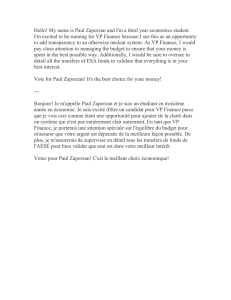
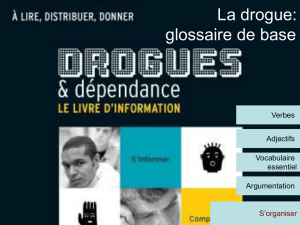
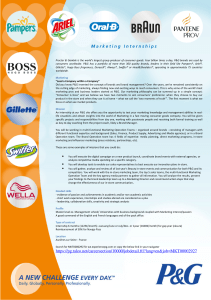

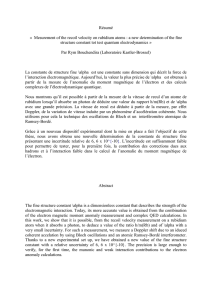


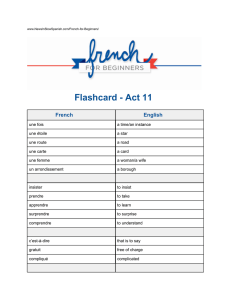
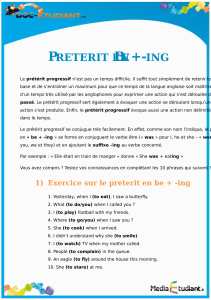
![The Enzymes, Chemistry and Mechanism o] Action, edited by](http://s1.studylibfr.com/store/data/004040712_1-47306fdc4a3811eb8dd0f228af791e56-300x300.png)
